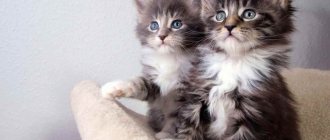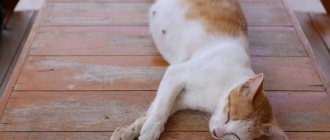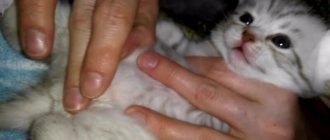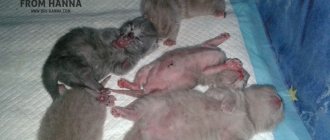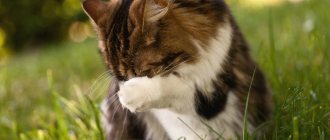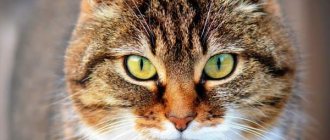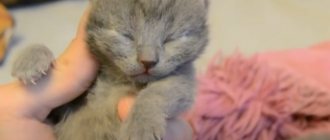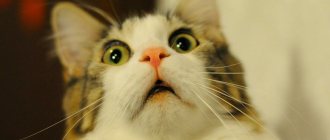If there is a new addition to your cat family, get ready for sleepless nights. And don’t even try to deceive yourself by the temporary helplessness of babies and their dependence on their mother.
Pretty soon, the fluffballs will stop crawling and confidently stand on all fours in search of adventure. At this point, you will have to answer for their safety. But knowing what time kittens begin to walk, you can protect them from possible problems, injuries and deviations.
From newborn to full member of feline society
Newborns weigh only 100 g. For the first 10 days they rely completely on their mother, as their senses are just beginning to develop.
Kittens are born blind, deaf and toothless. Their only reference point in space is their developed sense of smell. With its help, they can easily find mother's nipples located within 60 cm.
It takes a lot of time to develop into a full-fledged member of cat society. Each stage of growing up is unique and full of challenges, so try to give your pets all the support they need.
Eye opening
The eyes open 10-14 days after birth. The exact time depends on gender and coat length. Girls with short hair always mature earlier than boys with long hair.
Please note that all newborns have blue irises. With age, its color may change.
Teething
Milk teeth erupt on days 21-28, and after another 2 months their place is gradually taken by molars. By this point, the pets have already left the “nest”, and all poorly lying objects suffer from their new teeth.
Standing up and walking
Along with vision comes hearing. Thanks to new sensations, the world around us becomes more and more interesting.
Out of curiosity, kittens crawling on their tummy begin to make their first attempts to stand on their paws. At 3 weeks of life, they are already trying to walk, but they do it very clumsily and often fall. Their coordination improves by about 1 month.
First taste of adult food
Complementary foods are given at 1-1.5 months, when the cat’s breast milk supply begins to decrease. All food served is thoroughly boiled and crushed, achieving a liquid consistency. Solid foods are introduced into the diet only after all baby teeth have appeared.
When to give the baby to new owners?
Acquaintance with a new family should be done at 2.5-3 months. By this point, the diet of kittens is no longer different from that of an adult, so they cope much more easily with separation from their mother. This age is also optimal for vaccinations that provide immunity against the most common viruses.
New owners will have to go through 2 more stages with their mustachioed pets on the way to growing up: the first molt and puberty. After this, the active growth phase ends, and the animals are equated to adults.
When their eyes open
The process of eye opening in cubs of different breeds begins on the 5-9th day of life. Delays may occur if the baby was born weakened or the mother is not fed correctly.
Be sure to read:
Mating males and females: features, age, how to determine readiness, first mating, recommendations
Experienced breeders know breed differences. Beginning cat lovers should know that girls' eyes open earlier. Babies of long-haired breeds mature later than short-haired ones.
If the baby is 2 weeks old and its eyes have not opened, it is recommended to moisten them with strong tea or diluted boric acid and try to move them apart. In case of failure, contact an experienced felinologist or veterinarian.
How does a cat's locomotor system develop?
The musculoskeletal system consists of bones, muscles and joints. Only the hind legs are a direct continuation of the cat's skeleton. The forelimbs do not have a solid joint. They are connected to the skeleton by elastic and strong tendons. They provide smooth landings from great heights and a silent gait.
The hind legs are always stronger than the front legs, since they have to take a much larger load. They serve as support and help push off while running and jumping.
Full development of the body takes about a year, but motor function becomes available to babies already at 1 month of life. During this time they go through the following stages:
- Moving by crawling. In the first 5 days, pets move only in the direction of their mother to eat. By day 10, they begin to use their front legs. Pushing off the floor with them, the kittens ride more and more confidently on their bellies, like swimmers.
- Standing on your front paws. The first attempts are made in 1.5-2 weeks. By the end of this stage, the hind limbs also become stronger, expanding the available capabilities.
- First steps on 4 paws. When making their first movements, babies are guided by their mother. Repeating after her, they sway strongly and often fall out of the blue, but with each attempt they become closer to the goal.
- Gradual improvement of coordination to the level of adult animals. From the 3rd week, animals try to master not only walking, but also running and jumping. During the game, they can fight each other or hunt for their own tail.
The movements of whiskered pets at 1 month are very different from the timid attempts to learn to walk in the very first stages. By this age, small pets no longer fall over while running, actively play with each other and make confident jumps on low surfaces.
Expert advice
Veterinarians and experienced felinologists advise animal lovers who decide to get a kitten to do the following:
- Once pregnancy is established, the cat is switched to premium dry food or higher and is provided with sufficient food.
- At 2 weeks the baby's incisors erupt, and from three weeks the animal can chew granulated food. From this moment on, kittens are given dry food. By the age of two months, the cat's mouth will be armed with twenty-six teeth.
- For the safety of the babies, they are given a special playpen for kittens.
- The area around the cat's den is covered with carpet.
- Before the babies get stronger and begin to leave the nest, dangerous objects are removed.
Be sure to read:
Mating a British cat: features, preparation, optimal period, how they behave, what not to do
If the kitten is injured, call a veterinarian. You cannot hesitate, otherwise the cub will die or become disabled. Transport to a hospital may worsen the injury. The cat is kept motionless until the doctor appears.
When kittens start walking instead of crawling, what should you pay attention to?
The development of each animal is individual, so there is no need to rush things. Your main tasks are surveillance and security.
Small pets can start walking at completely different times. It all depends on the state of their body at the time of birth and the quality of nutrition.
If there are weakened kittens in the litter, help them find nipples or transfer them to artificial feeding. It is more difficult for such animals to compete with hungry brothers, so they often lag behind in development.
Track your cat's motor development at each stage. Pay special attention to week 3. If, when trying to stand on its legs, the baby squeaks loudly or limps heavily, take him to the vet.
The same should be done if you continue to crawl. Such symptoms may indicate congenital or acquired pathologies.
SEE THE STAGES OF KITTEN DEVELOPMENT IN THE KITTEN GROWTH TABLE
Let's consider all stages of development of kittens from birth to one year, their characteristics of maturation and growth, features of care at each age.
A newborn kitten is born weighing 80-120 grams, the size of kittens at birth is body length about 9-12 cm.
Very rarely, but still there are cases of the birth of kittens 50-70g, they are small but active. This does not always serve as a signal that the kitten is sick or has abnormalities. This also occurs in multiple pregnancies or in the case of small parents.
Newborn kittens: photo of the litter Newborn kittens are absolutely helpless during this period, they are blind, deaf, and do not know how to regulate their temperature. Newborn kittens have no undercoat; the fur is thin, weak and does not warm at all.
Possible problems and deviations
Treatment of the problem must begin immediately after its appearance. Otherwise, the pet may remain disabled.
Pain and weakness of the limbs are characteristic of the following pathologies:
- hip dysplasia, expressed in abnormal tissue development;
- liver diseases complicated by neurological disorders;
- acute intoxication;
- primary (arthritis) and secondary (trauma) dysfunctions of the musculoskeletal system;
- rickets, characterized by softening of the bones;
- malignant neoplasms.
The risk group includes Maine Coons. Due to active growth and large dimensions, 23% of representatives of this breed suffer from dysplasia. Their weight gain outpaces the development of joints, so the body simply cannot cope with the load placed on it. Also, this pathology can be inherited, and its presence must be recorded in the pedigree.
Please note that an animal suspected of being injured should not be transported. Shaking on the road can aggravate his condition, so it is better to call a doctor at home.
Features of caring for a small pet
A kitten is the same child, only a cat. He also needs a safe environment and attention from “adults.” For this reason, the growing baby should be provided with suitable conditions:
- Sharp objects, wires, household chemicals, etc. should be removed away from a curious cat.
- If your pet falls even from a small height, begins to limp or meows pitifully for no apparent reason, it is better to show it to the veterinarian. Kittens are much more likely to be injured and die than adult animals.
- It is not recommended to leave a kitten in the company of a small child or a larger pet, even if they are friendly. Playing in unequal weight categories can lead to tragedy.
- Babies have very fragile bone tissue, and if handled roughly or harshly, they often suffer serious injuries. You need to pick them up very carefully.
- When transporting a kitten, it is advisable to hold it in your arms, since any shaking can cause a broken limb.
- In a home environment, it is recommended to ensure that your pet does not jump off furniture or other objects, especially while he is clumsy and moves uncertainly.
- The kitten's bed should be in a secluded place, namely where it will not be frightened by sharp sounds, strangers and household members.
- The weak paws of a baby who has just learned to walk will slide on the slippery floor. To prevent this from happening, it is recommended to cover the floor with a short-pile rug. The kitten's walking area should be adapted to its needs.
And if everything goes according to plan, and the mother cat takes care of the offspring, then the owner should not worry. In some cases, children may not go on time. If the wait is prolonged and alarming signs are observed, it is better to consult a specialist.
Feeding a kitten deprived of maternal care
Unfortunately, there are situations when a kitten, for various reasons, is left without the care of its mother cat. In this case, the owner’s main task is to provide the newborn baby with the correct and timely diet. Feeding kittens left without a cat should be carried out in consultation with a veterinarian, who will determine the correct feeding schedule and tell you how to replace cat's milk with cow's milk without harm to the baby's health.
If the veterinarian is unavailable for some reason, here are a couple of recipes for preparing food for your pet:
- add 15 g of whole milk powder and 2.5 g of dry yeast to 50 g of cow's milk;
- add egg yolk and 4 teaspoons of granulated sugar to 0.5 liters of concentrated milk;
Scottish Fold kitten Until one month of age, kittens require 8-10 meals a day at equal intervals
It is important that the temperature of the milk is about 37 degrees, and the process of feeding the pet should be carried out using a pipette
When the baby is 3 weeks old, you can replace the pipette with a bottle with a nipple. Also, we must not forget about the need for a light massage of the tummy immediately after eating, this stimulates the work of the digestive system that has not yet become stronger.
Under no circumstances should overfeeding be allowed. You can determine that the baby is hungry by the shrill squeak that the kitten will make while crawling around its place in search of its mother.

